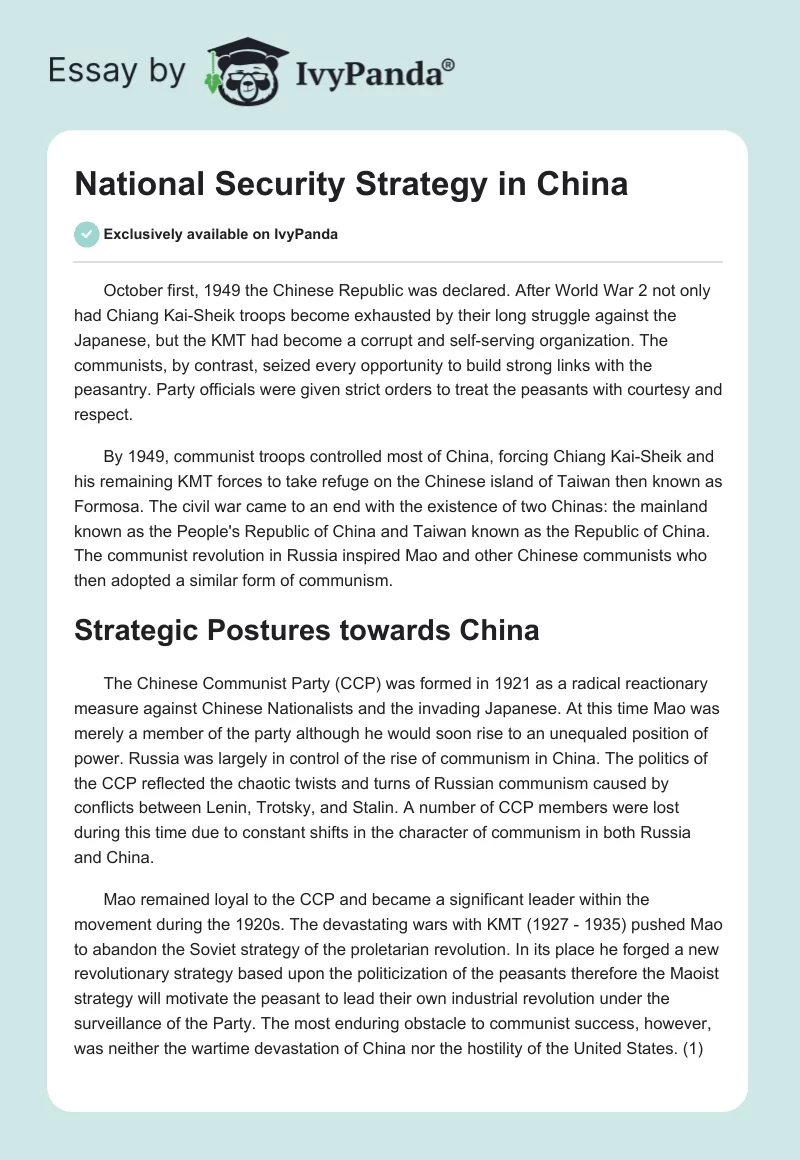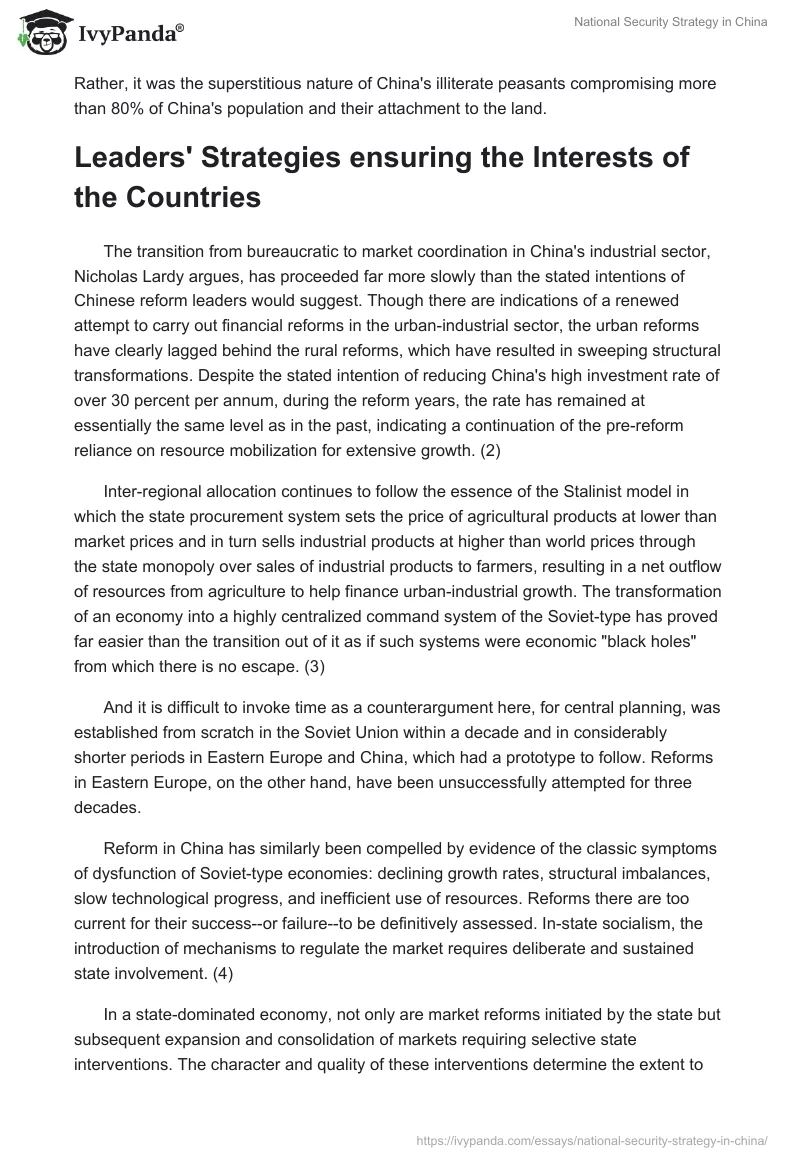October first, 1949 the Chinese Republic was declared. After World War 2 not only had Chiang Kai-Sheik troops become exhausted by their long struggle against the Japanese, but the KMT had become a corrupt and self-serving organization. The communists, by contrast, seized every opportunity to build strong links with the peasantry. Party officials were given strict orders to treat the peasants with courtesy and respect.
By 1949, communist troops controlled most of China, forcing Chiang Kai-Sheik and his remaining KMT forces to take refuge on the Chinese island of Taiwan then known as Formosa. The civil war came to an end with the existence of two Chinas: the mainland known as the People’s Republic of China and Taiwan known as the Republic of China. The communist revolution in Russia inspired Mao and other Chinese communists who then adopted a similar form of communism.
Strategic Postures towards China
The Chinese Communist Party (CCP) was formed in 1921 as a radical reactionary measure against Chinese Nationalists and the invading Japanese. At this time Mao was merely a member of the party although he would soon rise to an unequaled position of power. Russia was largely in control of the rise of communism in China. The politics of the CCP reflected the chaotic twists and turns of Russian communism caused by conflicts between Lenin, Trotsky, and Stalin. A number of CCP members were lost during this time due to constant shifts in the character of communism in both Russia and China.
Mao remained loyal to the CCP and became a significant leader within the movement during the 1920s. The devastating wars with KMT (1927 – 1935) pushed Mao to abandon the Soviet strategy of the proletarian revolution. In its place he forged a new revolutionary strategy based upon the politicization of the peasants therefore the Maoist strategy will motivate the peasant to lead their own industrial revolution under the surveillance of the Party. The most enduring obstacle to communist success, however, was neither the wartime devastation of China nor the hostility of the United States. Rather, it was the superstitious nature of China’s illiterate peasants compromising more than 80% of China’s population and their attachment to the land.
Leaders’ Strategies ensuring the Interests of the Countries
The transition from bureaucratic to market coordination in China’s industrial sector, Nicholas Lardy argues, has proceeded far more slowly than the stated intentions of Chinese reform leaders would suggest. Though there are indications of a renewed attempt to carry out financial reforms in the urban-industrial sector, the urban reforms have clearly lagged behind the rural reforms, which have resulted in sweeping structural transformations. Despite the stated intention of reducing China’s high investment rate of over 30 percent per annum, during the reform years, the rate has remained at essentially the same level as in the past, indicating a continuation of the pre-reform reliance on resource mobilization for extensive growth.
Inter-regional allocation continues to follow the essence of the Stalinist model in which the state procurement system sets the price of agricultural products at lower than market prices and in turn sells industrial products at higher than world prices through the state monopoly over sales of industrial products to farmers, resulting in a net outflow of resources from agriculture to help finance urban-industrial growth. The transformation of an economy into a highly centralized command system of the Soviet-type has proved far easier than the transition out of it as if such systems were economic “black holes” from which there is no escape.
And it is difficult to invoke time as a counterargument here, for central planning, was established from scratch in the Soviet Union within a decade and in considerably shorter periods in Eastern Europe and China, which had a prototype to follow. Reforms in Eastern Europe, on the other hand, have been unsuccessfully attempted for three decades.
Reform in China has similarly been compelled by evidence of the classic symptoms of dysfunction of Soviet-type economies: declining growth rates, structural imbalances, slow technological progress, and inefficient use of resources. Reforms there are too current for their success–or failure–to be definitively assessed. In-state socialism, the introduction of mechanisms to regulate the market requires deliberate and sustained state involvement.
In a state-dominated economy, not only are market reforms initiated by the state but subsequent expansion and consolidation of markets requiring selective state interventions. The character and quality of these interventions determine the extent to which market coordination replaces state planning and allocation of resources. If state interventions continue to specify particular courses of economic activity, especially at the local level, then markets are not likely to play a strong role in coordinating the socialist economy. For market reforms to be successful there must be a shift toward indirect macroeconomic regulatory interventions.
By the mid-1980s virtually all socialist countries seemed to be struggling with the task of transition. Today some of the socialist countries, primarily China, and to a lesser extent the Soviet Union, still have large agricultural populations, thus in principle, they could keep growing intensively. But they face a military challenge from the West, which is increasingly based on high technology, and they try to integrate themselves into a world economy in which technological change plays a far greater role than ever before. Under such circumstances it is not surprising that they may feel forced to try to achieve faster technological development, thereby entering the intensive growth stage somewhat prematurely.
In general, the Cultural Revolution reforms discussed here seem to display intolerance for the complexity and impurities of Chinese society and a desire to hasten the transition to a unified form of state socialism in which planners would dictate production, education, employment, consumption, and other goals and paternalistically allocate goods and services to citizens without relying on markets and personal choice. In this image the countryside would merge with the city, as collective forms of ownership would be raised up from team to brigade and then to the commune level, and finally, commune collective ownership would be transformed into state ownership, the dominant form in urban China.
The Impact on the Internal Development of China
The continued dominance of command planning in the dual-system model is dependent on a system of tight political control. The enlarged scope of market forces in the regulated-market model, by contrast, presupposes greater economic freedom among individual economic agents. Economic freedom may be indivisible from political freedom, and the efficient functioning of the market mechanism in the regulated-market model may therefore compel more democratic or pluralistic political structures. In spite of or perhaps because of the absence of a coherent blueprint for longer-term strategic reform, the industrial reform experiments in China during 1979-81 relied extensively upon the transitional system previously tried in the mid- 1950s.
The reform experiments were intended to adhere to the dual-system model. When a number of negative macroeconomic developments occurred, conservative reformers attributed them to an excessive pace and the premature extension of market relations beyond the scope prescribed by the dual-system model. They argued that before potentially disruptive market relations could be introduced on a wider scale, the apparatus of direct planning had to be considerably strengthened and improved.
Their determination is critical in a political system that remains highly centralized. The political centralization of communist states like China creates the opportunity for leadership initiatives to reform the command economy. And although the process of implementing economic reforms is pluralistic, with bureaucratic institutions contending for power and resources, the highly concentrated power of a few top leaders to set the policy agenda, shape an ideology of reform through the party-controlled mass media, and resolve the conflicts between subordinate bureaucratic agencies gives them the tools to manage the implementation process.
The Chinese leadership has demonstrated acumen in meeting the political challenge of carrying out economic reform. Deng Xiaoping initiated the drive for economic reform and continues to guide the “high” politics of reform, controlling and transforming the military, which is a potential source of opposition to economic reform; designing the reform of the administration and personnel practices; leading the limited political decontrol over culture; making high-level personnel decisions; and charting the future role and character of the Communist party.
References
Robert J. Morris, “Summoning Democracy, Justice, and Pluralism” Journal of Comparative Asian Development 4, no. 2 (2005): 337.
Chalmers Johnson, Peasant Nationalism, and Communist Power: The Emergence of evolutionary China, 1937-1945 (Stanford: Stanford University Press, 1962) 119-23.
Nicholas R. Lardy, Agriculture in China’s Modern Economic Development (Cambridge, Eng.: Cambridge University Press, 1983) 85-90.
William L. Parish and Martin K. Whyte, Village and Family in Contemporary China (Chicago: University of Chicago Press, 1978) 65-69.
Dwight Perkins, “Growth and Changing Structure of China’s Twentieth Century Economy,” in Perkins, ed., China’s Modern Economy in Historical Perspective (Stanford: Stanford University Press, 1975), pp. 115-65.
Dewey, Confucius, and the Hope for Democracy in China (Chicago: Open Court, 1999), p. 216.
Alice Erh-Soon Tay, “Legal Culture and Legal Pluralism in Common Law, Customary Law, and Chinese Law,” Hong Kong Law Journal 26, (1996): 194-203.
Chow Tse-Tsung, The May 4th Movement: Intellectual Revolution in Modern China (Cambridge: Harvard University Press, 1960). 210-14.
Ramon H. Myers, “Political Theory and Recent Political Developments in the Republic of China,” Asian Survey 27, no. 9 (2002): 1003.


